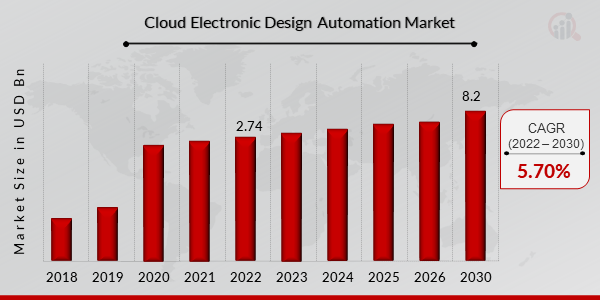Cost Efficiency
Cost efficiency remains a pivotal driver in the Cloud Electronic Design Automation Market. Organizations are increasingly drawn to cloud-based EDA solutions due to their potential to reduce operational costs. By leveraging cloud infrastructure, companies can minimize the need for extensive on-premises hardware and associated maintenance expenses. Reports suggest that businesses can save up to 30% on their design costs by transitioning to cloud-based platforms. This financial incentive is particularly appealing to small and medium-sized enterprises that may lack the resources for traditional EDA tools. As the market evolves, the emphasis on cost-effective solutions is expected to drive further adoption of cloud EDA technologies.
Enhanced Collaboration
Enhanced collaboration is a significant driver within the Cloud Electronic Design Automation Market. The shift to cloud-based EDA tools facilitates real-time collaboration among design teams, regardless of geographical location. This capability is particularly beneficial in an increasingly remote work environment, where teams can share designs, provide feedback, and make adjustments instantaneously. The ability to collaborate seamlessly can lead to faster project completion times and improved design quality. Data indicates that companies utilizing cloud EDA solutions report a 25% increase in team productivity, underscoring the importance of collaborative tools in modern design workflows. This trend is likely to continue as organizations prioritize efficient teamwork.
Scalability and Flexibility
The Cloud Electronic Design Automation Market is experiencing a surge in demand for scalable and flexible solutions. As organizations increasingly seek to optimize their design processes, the ability to scale resources up or down based on project requirements becomes crucial. This flexibility allows companies to manage costs effectively while ensuring that they can meet the demands of complex design tasks. According to recent data, the market for cloud-based EDA tools is projected to grow at a compound annual growth rate of over 20% in the coming years, indicating a strong preference for solutions that can adapt to varying workloads. This trend is likely to continue as more firms recognize the benefits of cloud infrastructure in enhancing their design capabilities.
Regulatory Compliance and Security
Regulatory compliance and security concerns are increasingly influencing the Cloud Electronic Design Automation Market. As organizations navigate complex regulatory landscapes, the need for secure and compliant EDA solutions becomes paramount. Cloud providers are investing heavily in security measures to protect sensitive design data, which is critical for maintaining competitive advantage. The market is responding to these needs by offering solutions that not only comply with industry standards but also provide robust security features. Data suggests that companies prioritizing security in their EDA tools experience a 40% reduction in data breaches, highlighting the importance of secure cloud environments. This focus on compliance and security is likely to shape future developments in the market.
Integration with Advanced Technologies
The integration of advanced technologies is driving innovation in the Cloud Electronic Design Automation Market. The incorporation of artificial intelligence and machine learning into cloud-based EDA tools enhances design capabilities, enabling automated processes and predictive analytics. This integration allows designers to identify potential issues early in the design phase, reducing time and costs associated with revisions. Furthermore, the market is witnessing a growing trend towards the use of Internet of Things (IoT) technologies, which can provide valuable data for design optimization. As these advanced technologies become more prevalent, their synergy with cloud EDA solutions is expected to propel market growth.


















Leave a Comment